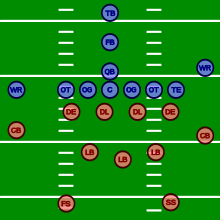Offense
Offense ( English for attack ) is a technical term for the attacking team in American football . Your task is to get into the opposing end zone to score points. The defending team tries to stop them.
Positions
The offense consists of eleven players, of which at least seven players must line up on the Line of Scrimmage (LoS) at the start of the game turn . These players are usually the five players on the offensive line plus two other players. In simple standard formations, these are the tight end (TE) and the split end (SE) - one of the wide receivers (WR). The center (C) puts the ball into play at the beginning of the play. The center is flanked by the guards (OG or G) ( Left Guard (LG) and Right Guard (RG)). Next to the guards are the two offensive tackles (OT). Players on the offensive line are not allowed to catch. Both ends are entitled to catch, provided they have a legal jersey number and there is no other player on the line of scrimmage on their side.
The most important position in the course of the game is the quarterback (QB), who together with the head coach (or the offensive coordinator ) determines the moves and throws the ball or hands it over. The running back (RB) is the potential recipient of the ball in the running game , who is usually behind or next to the quarterback. In some lineups there are two or no running backs at all. In addition, there are tight ends and wide receivers in the attack, which almost only catch balls. The other task of the tight end is to clear the way for the running back or to act as an additional blocker in the passing game . A good receiver has to be fast, moderately difficult and very agile in order to be able to avoid the tackles of the opposing safeties and cornerbacks . In addition, a distinction is made between fullback (FB) and halfback (HB) when it comes to running backs.
Formations
The basic requirement for an offense formation is at least seven players directly on the line of scrimmage. These players have, apart from the tight ends or, where appropriate Wide receivers, the numbers 50 to 79 and are thus ineligible receiver , so it is not lawful for them to catch passes that not, for example, a fumble or a touch by a player free were. There are mainly five formations with various variations. The best known is the I formation , in which the running backs stand in a row behind the quarterback standing directly behind the center. There are, in turn, modifications to this list in which the fullback is a little more to the right or left, these are then treated with the addition of offset . A variant that is often used is the Power I , in which an additional running back is positioned to the right or left of the other running backs. The T-formation is similar to the Power I, but the rear running back is right next to the middle one, so the line-up looks like a "T". In the pro-set formation, there are two running backs behind the quarterback, offset as in the T formation, but without a middle running back. If there is another one in front of the two running backs, that is a wishbone formation ( English for divining rod formation). Another well-known formation is the shotgun , in which the quarterback is not directly behind the center in order to have more time before he is tackled . This line-up is often used when the team still needs many yards to first down . This setup is also sometimes used with five wide receivers, i.e. without tight end or running back. A formation for similar situations is the Empty Backfield Formation (English for Empty Backfield Formation), in which five wide receivers and no running back are set up.
Specializations
Each offense is trained on a special tactic, which is usually determined by the strengths of the players. If the team has a good running back, they have a better quarterback and wide receiver throws the ball more often. There are also teams in which the running and throwing elements are equally strong or only slightly different. There is then a lot of running and passing. These specializations also exist in defense. So if an offense with good running backs meets a defense with a good pass defense, but a relatively poor running defense, the offense has an advantage.
See also
swell
- American Football Coaches Association: The Football Coaching Bible , Human Kinetics Pub Inc, ISBN 0736044116
